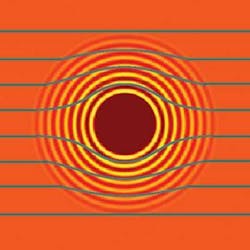Invisibility cloaking of matter on the scale of the Romulans and Harry Potter is still firmly science fiction, but recent experiments have demonstrated optical metamaterials with properties that deflect microwave beams to “hide” microscopic objects (see www.laserfocusworld.com/articles/322012). Now, a scheme created by professor of mechanical engineering Xiang Zhang and his group at the University of California, Berkeley (Berkeley, CA), has exploited an optical lattice to deflect matter waves around an object, in effect using light to hide matter from matter.
Using time-invariant coordinate transformations of Schrödinger’s equations, the design shows that it is possible to hide a spherical object within a cloaking shell or medium so that it is invisible to both incident quantum waves and impinging classical particles. The deflecting medium, in this case, is a three-dimensional (3-D) optical lattice of laser beams, consisting of optical standing waves with gradually varying amplitude along the radial direction. The system specifies perfect impedance matching at the cloak’s outer shell and a carefully chosen external magnetic potential. The varying amplitude of the optical lattice changes the effective mass and band energy of the hidden object as another atom or wave moves near it, causing the stream of particles or incident quantum waves to bend and come out on the other side object as if it were not there (see figure).
The group devised a material system incorporating rubidium (Rb) atoms cooled to 4.5 nK, which causes the quantum-wave aspect of the atoms to dominate over their particle properties. In the proposed cloaking system, the quantum wavelength of the Rb atoms is set at 5 µm, ten times longer than the optical lattice period of 427 nm, so that the optical lattice acts as an effective medium. For a hidden sphere of atoms measuring 200 µm in diameter, within an optical lattice 800 µm in diameter, the scattering cross-section of outgoing matter waves is reduced by a factor of 250, effectively achieving cloaking.
The researchers point out that putting the optical-cloaking system into practice faces challenges. One practical limitation is that, while complex two-dimensional (2-D) optical lattices have been produced, a 3-D spherically concentric cloaking system for cooled atoms would be difficult to construct. But the simple idea that it’s possible to extend invariant coordinate transformations to quantum systems enables unprecedented control of incident quantum waves, which may result in new phenomena and applications such as controlling electrons in crystal systems, radiation shielding, and particle-beam steering. Other applications may include matter-wave negative refraction and sub-diffraction-limit quantum imaging.
A new direction?
“These novel capabilities may open a new field in quantum mechanics, much like metamaterials did for electromagnetism,” said team member Shuang Zhang. “The implementation of metamaterials for quantum-mechanical systems could take physics in a new direction.”
Although the Berkeley group is looking into other material systems to achieve quantum-wave cloaking, they have no plans to pursue experimental verification of the scheme in the near future. “However,” said Shuang, “several other groups have the know-how to make the effective media we propose.” Of note are professor Massimo Inguscio’s group at the European Laboratory for Non-Linear Spectroscopy (LENS; Firenze, Italy) and professor Immanuel Bloch’s group researching ultracold quantum gases at Johannes-Gutenberg University (Mainz, Germany); both groups are working with manipulating cold atoms using magnetic traps and optical lattices.2, 3
REFERENCES
1. S. Zhang et al., Phys. Rev. Lett. 100, 123002 (Mar. 24, 2008).
2. F. S. Cataliotti et al., Science 293, 843 (2001).
3. B. Paredes et al., Nature 429, 227 (2004).

